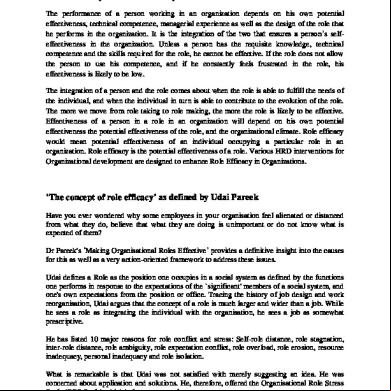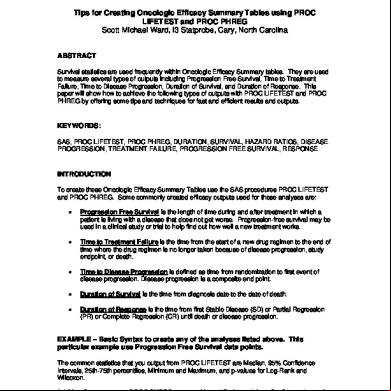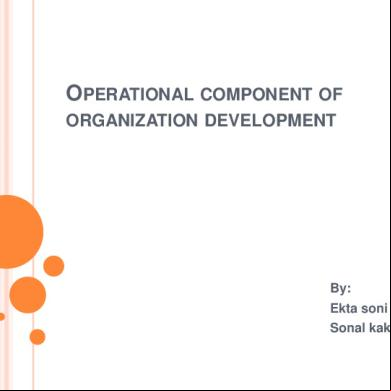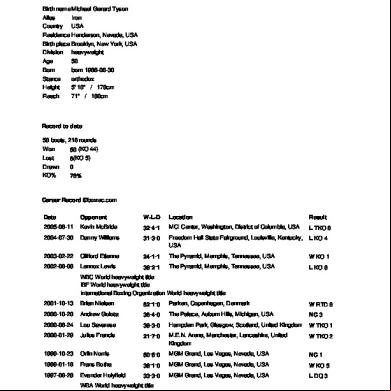Role Efficacy 5jj5c
This document was ed by and they confirmed that they have the permission to share it. If you are author or own the copyright of this book, please report to us by using this report form. Report 2z6p3t
Overview 5o1f4z
& View Role Efficacy as PDF for free.
More details 6z3438
- Words: 1,090
- Pages: 4
Role Efficacy: A Work Sub-system The performance of a person working in an organization depends on his own potential effectiveness, technical competence, managerial experience as well as the design of the role that he performs in the organization. It is the integration of the two that ensures a person’s selfeffectiveness in the organization. Unless a person has the requisite knowledge, technical competence and the skills required for the role, he cannot be effective. If the role does not allow the person to use his competence, and if he constantly feels frustrated in the role, his effectiveness is likely to be low. The integration of a person and the role comes about when the role is able to fulfill the needs of the individual, and when the individual in turn is able to contribute to the evolution of the role. The more we move from role taking to role making, the more the role is likely to be effective. Effectiveness of a person in a role in an organization will depend on his own potential effectiveness the potential effectiveness of the role, and the organizational climate. Role efficacy would mean potential effectiveness of an individual occupying a particular role in an organization. Role efficacy is the potential effectiveness of a role. Various HRD interventions for Organizational development are designed to enhance Role Efficacy in Organizations.
‘The concept of role efficacy’ as defined by Udai Pareek Have you ever wondered why some employees in your organisation feel alienated or distanced from what they do, believe that what they are doing is unimportant or do not know what is expected of them? Dr Pareek's ‘Making Organisational Roles Effective’ provides a definitive insight into the causes for this as well as a very action-oriented framework to address these issues. Udai defines a Role as the position one occupies in a social system as defined by the functions one performs in response to the expectations of the `significant' of a social system, and one's own expectations from the position or office. Tracing the history of job design and work reorganisation, Udai argues that the concept of a role is much larger and wider than a job. While he sees a role as integrating the individual with the organisation, he sees a job as somewhat prescriptive. He has listed 10 major reasons for role conflict and stress: Self-role distance, role stagnation, inter-role distance, role ambiguity, role expectation conflict, role overload, role erosion, resource inadequacy, personal inadequacy and role isolation. What is remarkable is that Udai was not satisfied with merely suggesting an idea. He was concerned about application and solutions. He, therefore, offered the Organisational Role Stress Scale (ORS Scale) which helps measure role stresses.
Having defined role stress and helped measure it, Udai goes on to define and explain role efficacy. He defines Role Efficacy as the potential effectiveness of a role or the psychological factors underlying role effectiveness. He has outlined 10 aspects of role efficacy (Fig. 1) arranged under three dimensions.
ROLE-MAKING An employee needs to look forward to making and understanding his own Role, rather than waiting for others to tell him what his Role is. This can be achieved by: •Self-Role Integration: Integration between self-concept and Role demands rather than distancing self from the Role. •Proactivity: Initiating actions on own rather than reacting to situations. •Creativity: Experimenting and trying new ideas/ strategies rather than operating on routine. •Confrontation: Facing problem to attempt their solution rather than avoiding the problems. Udai saw the self and role integrating when a person occupied a role that provided him with the opportunity to use his special strengths and skills.
ROLE CENTRING While the first dimension focuses on the individual, the second dimension focuses on the job design aspects. An employee needs to look forward to Role Centering and making his own Role important, rather than making his Role unimportant. This can be achieved by: •Centrality: Feeling important or central in a system rather than becoming peripheral in the system. •Influence: Feeling that his Role can make some impact in the system rather than feeling powerless. •Growth: Feeling that one occupying the Role grows and learns in the Role rather than feeling stagnated.
ROLE LINKING An employee needs to look forward to Role linking and understand that his Role is an important part of the system and is based on mutuality, rather than shrinking his Role. This can be achieved by: •Role Linkage: Linkage of one’s Role with other’s Role rather than being and feeling isolated. •Helping Relationships: Giving and receiving help amongst Roles rather than becoming hostile towards others. •Super ordination: Linkage of one’s Role with larger entity rather than being deprived. Figure 1: Ten Aspects of Role Efficacy
Measuring Role Efficacy Udai goes on to offer two specific tools to measure role efficacy - Essay on my Role (EMR) and the famous Role Efficacy Scale. These two tools help practitioners measure and enhance role efficacy. Below mentioned are a few techniques most widely used for measuring Role Efficacy: 1) WRITING THE ESSAY The best method of measuring role efficacy is the EMR. It gives a high pay-off especially in programmes of increasing role efficacy. The role occupant may be asked to write an essay of about 500 words on his role which is then analyzed for role efficacy. When a person writes such an essay, he projects his perceptions about the role and provides enough material from which role efficacy can be measured.
2) SCORING ESSAYS The essays can be scored either by the one who writes the essay or by an expert. Each aspect can be given one of the three scores: +2, +1, or -1. After trying out various ways of scoring, this was the method decided upon: give a score of 2 on each aspect, if that particular aspect is present; score of 1 when that aspect is present to some extent; -1 if the negative side of the aspect is shown. 3) ROLE EFFICACY SCALE Role Efficacy Scale is a structured instrument consisting of 20 triads of statements. A respondent marks one statement in each triad which describes his role most accurately. These three alternatives are pre-weighted. There are two statements for each dimension of role efficacy and the same scoring pattern isfollowed. 4) INTERVIEW An unstructured interview with a role occupant to know his perceptions about the role can help collect data for scoring role efficacy. Interview has an advantage, it gets spontaneous responses, and necessary probes can be made to find out more about the various dimensions.
‘The concept of role efficacy’ as defined by Udai Pareek Have you ever wondered why some employees in your organisation feel alienated or distanced from what they do, believe that what they are doing is unimportant or do not know what is expected of them? Dr Pareek's ‘Making Organisational Roles Effective’ provides a definitive insight into the causes for this as well as a very action-oriented framework to address these issues. Udai defines a Role as the position one occupies in a social system as defined by the functions one performs in response to the expectations of the `significant' of a social system, and one's own expectations from the position or office. Tracing the history of job design and work reorganisation, Udai argues that the concept of a role is much larger and wider than a job. While he sees a role as integrating the individual with the organisation, he sees a job as somewhat prescriptive. He has listed 10 major reasons for role conflict and stress: Self-role distance, role stagnation, inter-role distance, role ambiguity, role expectation conflict, role overload, role erosion, resource inadequacy, personal inadequacy and role isolation. What is remarkable is that Udai was not satisfied with merely suggesting an idea. He was concerned about application and solutions. He, therefore, offered the Organisational Role Stress Scale (ORS Scale) which helps measure role stresses.
Having defined role stress and helped measure it, Udai goes on to define and explain role efficacy. He defines Role Efficacy as the potential effectiveness of a role or the psychological factors underlying role effectiveness. He has outlined 10 aspects of role efficacy (Fig. 1) arranged under three dimensions.
ROLE-MAKING An employee needs to look forward to making and understanding his own Role, rather than waiting for others to tell him what his Role is. This can be achieved by: •Self-Role Integration: Integration between self-concept and Role demands rather than distancing self from the Role. •Proactivity: Initiating actions on own rather than reacting to situations. •Creativity: Experimenting and trying new ideas/ strategies rather than operating on routine. •Confrontation: Facing problem to attempt their solution rather than avoiding the problems. Udai saw the self and role integrating when a person occupied a role that provided him with the opportunity to use his special strengths and skills.
ROLE CENTRING While the first dimension focuses on the individual, the second dimension focuses on the job design aspects. An employee needs to look forward to Role Centering and making his own Role important, rather than making his Role unimportant. This can be achieved by: •Centrality: Feeling important or central in a system rather than becoming peripheral in the system. •Influence: Feeling that his Role can make some impact in the system rather than feeling powerless. •Growth: Feeling that one occupying the Role grows and learns in the Role rather than feeling stagnated.
ROLE LINKING An employee needs to look forward to Role linking and understand that his Role is an important part of the system and is based on mutuality, rather than shrinking his Role. This can be achieved by: •Role Linkage: Linkage of one’s Role with other’s Role rather than being and feeling isolated. •Helping Relationships: Giving and receiving help amongst Roles rather than becoming hostile towards others. •Super ordination: Linkage of one’s Role with larger entity rather than being deprived. Figure 1: Ten Aspects of Role Efficacy
Measuring Role Efficacy Udai goes on to offer two specific tools to measure role efficacy - Essay on my Role (EMR) and the famous Role Efficacy Scale. These two tools help practitioners measure and enhance role efficacy. Below mentioned are a few techniques most widely used for measuring Role Efficacy: 1) WRITING THE ESSAY The best method of measuring role efficacy is the EMR. It gives a high pay-off especially in programmes of increasing role efficacy. The role occupant may be asked to write an essay of about 500 words on his role which is then analyzed for role efficacy. When a person writes such an essay, he projects his perceptions about the role and provides enough material from which role efficacy can be measured.
2) SCORING ESSAYS The essays can be scored either by the one who writes the essay or by an expert. Each aspect can be given one of the three scores: +2, +1, or -1. After trying out various ways of scoring, this was the method decided upon: give a score of 2 on each aspect, if that particular aspect is present; score of 1 when that aspect is present to some extent; -1 if the negative side of the aspect is shown. 3) ROLE EFFICACY SCALE Role Efficacy Scale is a structured instrument consisting of 20 triads of statements. A respondent marks one statement in each triad which describes his role most accurately. These three alternatives are pre-weighted. There are two statements for each dimension of role efficacy and the same scoring pattern isfollowed. 4) INTERVIEW An unstructured interview with a role occupant to know his perceptions about the role can help collect data for scoring role efficacy. Interview has an advantage, it gets spontaneous responses, and necessary probes can be made to find out more about the various dimensions.










